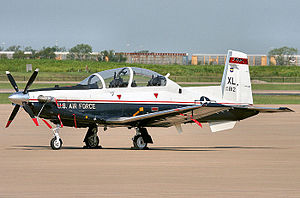Joint Primary Aircraft Training System
| Joint Primary Aircraft Training System (JPATS) | |
|---|---|
 |
|
| A USAF T-6A Texan II at Laughlin AFB, Texas | |
| Project for | Primary training aircraft |
| Service |
United States Air Force United States Navy |
| Proposals |
Cessna 526 CitationJet Embraer EMB-312H Super Tucano Vought Pampa 2000 Lockheed T-Bird II Beech-Pilatus PC-9 Mk 2 Rockwell Ranger 2000 SIAI Marchetti S.211 |
| Date concluded | 1995 |
| Outcome | Beech-Pilatus PC-9 Mk 2 selected for production as the Beechcraft T-6 Texan II |
| Predecessor programs | Next Generation Trainer (NGT) |
The Joint Primary Aircraft Training System (JPATS) was an aircraft procurement program of the United States in the 1990s by the United States Air Force and United States Navy, a merger of 1980s era training aircraft programs. The winner was declared in 1995 and entered service a few years later as the Beechcraft T-6 Texan II. The program was partly a result of the cancelled Fairchild Republic T-46 of the 1980s.
In 1995, the selection of Beech Aircraft Corporation of Wichita, Kansas, to develop and deliver the JPATS was made. The aircraft would be manufactured by Raytheon, Beechraft's parent company, starting in the late 1990s and into the early 21st century. The companies that initially responded and competed were Vought, Northrop, Grumman, Rockwell, Beechcraft, Lockheed, and Cessna. However, by the time the selection was over, Northrop, Grumman, and Vought were all part of the same larger company. Over 700 JPATS are intended to be bought over time.
In 1988, the United States Navy (USN) and the United States Air Force (USAF) were at a unique moment in history; they reached a point where they could work together, and provide a cost-effective solution to pilot production, specifically primary training. Both services needed to modernize their fleets of training aircraft.
The USAF and the USN cleared the first major obstacle on the subject of commonality. Each service preferred a different seating configuration. The USAF preferred the side-by-side configuration, while the USN preferred the tandem configuration. These preferences may have been due to each service’s previous experience in training aircraft. The T-37 is a side-by-side configuration, while the T-34C is a tandem arrangement. The hurdle was cleared when both services agreed on the tandem configuration.
The JPATS selection process began on 18 May 1994, when the RFP was issued. Seven contractors responded to the JPATS RFP:
The process took fourteen months and entailed evaluations of seven aircraft, seven cockpit mockups, and thousands of pages of contractor proposals.
...
Wikipedia
